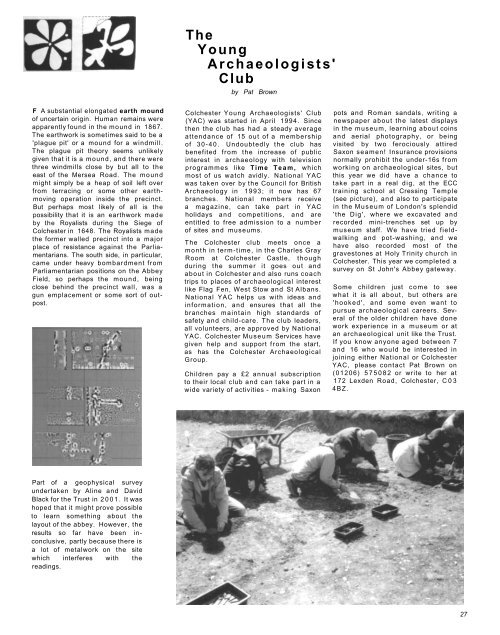The Colchester Archaeologist 2002 - Colchester Archaeological Trust
The Colchester Archaeologist 2002 - Colchester Archaeological Trust
The Colchester Archaeologist 2002 - Colchester Archaeological Trust
You also want an ePaper? Increase the reach of your titles
YUMPU automatically turns print PDFs into web optimized ePapers that Google loves.
<strong>The</strong><br />
Young<br />
<strong>Archaeologist</strong>s'<br />
Club<br />
by Pat Brown<br />
F A substantial elongated earth mound<br />
of uncertain origin. Human remains were<br />
apparently found in the mound in 1867.<br />
<strong>The</strong> earthwork is sometimes said to be a<br />
'plague pit' or a mound for a windmill.<br />
<strong>The</strong> plague pit theory seems unlikely<br />
given that it is a mound, and there were<br />
three windmills close by but all to the<br />
east of the Mersea Road. <strong>The</strong> mound<br />
might simply be a heap of soil left over<br />
from terracing or some other earthmoving<br />
operation inside the precinct.<br />
But perhaps most likely of all is the<br />
possibility that it is an earthwork made<br />
by the Royalists during the Siege of<br />
<strong>Colchester</strong> in 1648. <strong>The</strong> Royalists made<br />
the former walled precinct into a major<br />
place of resistance against the Parliamentarians.<br />
<strong>The</strong> south side, in particular,<br />
came under heavy bombardment from<br />
Parliamentarian positions on the Abbey<br />
Field, so perhaps the mound, being<br />
close behind the precinct wall, was a<br />
gun emplacement or some sort of outpost.<br />
<strong>Colchester</strong> Young <strong>Archaeologist</strong>s' Club<br />
(YAC) was started in April 1994. Since<br />
then the club has had a steady average<br />
attendance of 15 out of a membership<br />
of 30-40. Undoubtedly the club has<br />
benefited from the increase of public<br />
interest in archaeology with television<br />
programmes like Time Team, which<br />
most of us watch avidly. National YAC<br />
was taken over by the Council for British<br />
Archaeology in 1993; it now has 67<br />
branches. National members receive<br />
a magazine, can take part in YAC<br />
holidays and competitions, and are<br />
entitled to free admission to a number<br />
of sites and museums.<br />
<strong>The</strong> <strong>Colchester</strong> club meets once a<br />
month in term-time, in the Charles Gray<br />
Room at <strong>Colchester</strong> Castle, though<br />
during the summer it goes out and<br />
about in <strong>Colchester</strong> and also runs coach<br />
trips to places of archaeological interest<br />
like Flag Fen, West Stow and St Albans.<br />
National YAC helps us with ideas and<br />
information, and ensures that all the<br />
branches maintain high standards of<br />
safety and child-care. <strong>The</strong> club leaders,<br />
all volunteers, are approved by National<br />
YAC. <strong>Colchester</strong> Museum Services have<br />
given help and support from the start,<br />
as has the <strong>Colchester</strong> <strong>Archaeological</strong><br />
Group.<br />
Children pay a £2 annual subscription<br />
to their local club and can take part in a<br />
wide variety of activities - making Saxon<br />
pots and Roman sandals, writing a<br />
newspaper about the latest displays<br />
in the museum, learning about coins<br />
and aerial photography, or being<br />
visited by two ferociously attired<br />
Saxon seamen! Insurance provisions<br />
normally prohibit the under-16s from<br />
working on archaeological sites, but<br />
this year we did have a chance to<br />
take part in a real dig, at the ECC<br />
training school at Cressing Temple<br />
(see picture), and also to participate<br />
in the Museum of London's splendid<br />
'the Dig', where we excavated and<br />
recorded mini-trenches set up by<br />
museum staff. We have tried fieldwalking<br />
and pot-washing, and we<br />
have also recorded most of the<br />
gravestones at Holy Trinity church in<br />
<strong>Colchester</strong>. This year we completed a<br />
survey on St John's Abbey gateway.<br />
Some children just come to see<br />
what it is all about, but others are<br />
'hooked', and some even want to<br />
pursue archaeological careers. Several<br />
of the older children have done<br />
work experience in a museum or at<br />
an archaeological unit like the <strong>Trust</strong>.<br />
If you know anyone aged between 7<br />
and 16 who would be interested in<br />
joining either National or <strong>Colchester</strong><br />
YAC, please contact Pat Brown on<br />
(01206) 575082 or write to her at<br />
172 Lexden Road, <strong>Colchester</strong>, C03<br />
4BZ.<br />
Part of a geophysical survey<br />
undertaken by Aline and David<br />
Black for the <strong>Trust</strong> in 2001. It was<br />
hoped that it might prove possible<br />
to learn something about the<br />
layout of the abbey. However, the<br />
results so far have been inconclusive,<br />
partly because there is<br />
a lot of metalwork on the site<br />
which interferes with the<br />
readings.<br />
27

















